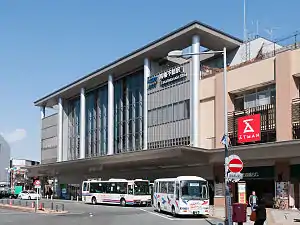Takahatafudō Station
Takahatafudō Station (高幡不動駅, Takahatafudō-eki) is a railway and monorail station on located in Hino, Tokyo, Japan. Most of the passengers boarding at Takahatafudō are commuters and students bound for central Tokyo, while those disembarking are visiting the Kongō-ji Temple or are students transferring to the monorail or buses.
Takahatafudō Station 高幡不動駅 | |
|---|---|
 Keiō Takahatafudō Station, February 2011 | |
| Location | Takahata, Hino-shi, Tokyo (東京都日野市高幡) Japan |
| Operated by |
|
| Line(s) | |
| Connections |
|
| Location | |
 Takahatafudō Station Location within Japan | |
Lines
Takahatafudō Station is served by the Keio Line, and is located 29.7 kilometers from the starting point of the line at Shinjuku Station. It is also the terminus of the Keiō Dōbutsuen Line. The Tama Toshi Monorail Line also serves Takahatafudō Station.
Station layout
Takahatafudō Station 高幡不動駅 | |
|---|---|
| Keio railway station | |
 Keiō Takahatafudō Station (south side) | |
| Location | 139 Takahata, Hino-shi, Tokyo (東京都日野市高幡139番地) Japan |
| Operated by | |
| Line(s) | |
| Platforms | 2 island + 1 side platform |
| Connections |
|
| Other information | |
| Station code | KO29 |
| History | |
| Opened | 1925 |
| Previous names | Takahata (until 1937) |
| Passengers | |
| FY2013 | 59,537 |
Keio Corporation
The Keio station has two island platforms with four tracks for the Keio Line, and one side platform for the Keio Dōbutsuen Line. All trains stop at this station.
Platforms
| 1 | ■ Keio Dōbutsuen Line | for Tama-Dōbutsukōen |
| 2/3 | ■ Keio Line | for Kitano, Keiō-Hachiōji, and Takaosanguchi |
| 4/5 | ■ Keiō Line | for Fuchū, Chōfu, Meidaimae, Sasazuka, and Shinjuku Toei Shinjuku Line |
Adjacent stations
| « | Service | » | ||
|---|---|---|---|---|
| Keio Line | ||||
| Seiseki-Sakuragaoka | Keiō Liner | Kitano | ||
| Seiseki-Sakuragaoka | Special Express | Kitano | ||
| Seiseki-Sakuragaoka | Semi Special Express | Kitano | ||
| Seiseki-Sakuragaoka | Express | Kitano | ||
| Mogusaen | Semi Express | Minamidaira | ||
| Mogusaen | Rapid | Minamidaira | ||
| Mogusaen | Local | Minamidaira | ||
| Keio Dōbutsuen Line | ||||
| Seiseki-Sakuragaoka | Express | Tama-Dōbutsukōen | ||
| Terminus | Local | Tama-Dōbutsukōen | ||
Takahatafudō Station 高幡不動駅 | |
|---|---|
| monorail station | |
 Takahatafudō Station (Tama Monorail) | |
| Location | 1039-1 Takahata, Hino-shi, Tokyo (東京都日野市高幡1039番地の1 ) Japan |
| Operated by | |
| Line(s) | ■ Tama Toshi Monorail Line |
| Platforms | 2 side platforms |
| Connections |
|
| Other information | |
| Station code | |
| History | |
| Opened | 2000 |
| Passengers | |
| FY2013[1] | 13,087 |
Tama Toshi Monorail
Takahatafudō Station is a raised station with two tracks and two opposed side platforms, with the station building located underneath. It is a standardized station building for this monorail line. Due to the concentration of university campuses towards Tama-Center, many students change trains at this station.
Platforms
| 1 | ■ Tama Toshi Monorail Line | Tachikawa-Kita, Tamagawa-Jōsui, Kamikitadai |
| 2 | ■ Tama Toshi Monorail Line | Takahatafudō, Tama-Center |
History
- March 24, 1925: Takahata Station opens along with the opening of the Gyokunan Electric Railway (now Keio Line), in a different location than the current station building.
- May 1, 1937: Station renamed from Takahata Station to Takahatafudō Station.
- 1957: Four-car rapid and semi-rapid trains to Shinjuku begin operating during peak periods.
- April 29, 1964: The Tama Dōbutsuen Line (now Dōbutsuen Line) opens. Station building moved to current location.
- January 10, 2000: The Tama Toshi Monorail Line station opens.
- March 2004: Station building shopping area construction begins.
- August 2004: Station building elevation construction begins.
- December 2004: Shopping area construction completed.
- March 25, 2007: Station building elevation complete, linking the Keio and monorail station areas and shopping areas.
Surrounding area
The namesake of the station is Kongōji Temple, also known as Takahatafudō, one of the great temples of the Kantō region. The area's development was guided first by worshippers visiting the temple, then by suburbanization during the 1960s and 1970s. The station is a major transportation hub for Hino, with many municipal facilities and shopping centers in the vicinity.
References
- 駅別乗車人員(一日平均) Archived 2016-03-04 at the Wayback Machine
External links
| Wikimedia Commons has media related to Takahatafudō Station. |
- Keio Corporation - Takahatafudō Station (in Japanese)
- Tama Monorail Takahatafudō Station (in Japanese)
- Keio Takahata Shopping Center (in Japanese)